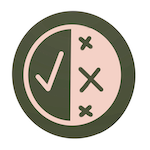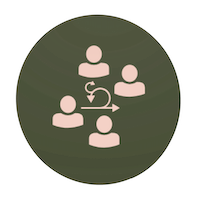The Beginner’s Guide To Agile Consulting
In my experience, both as a consultant and a client, I've seen teams and organizations waste huge amounts of energy and resources pursuing inefficient approaches to solving problems.
As a result, I've often felt as if there was no time left to do agile the right way.
As a consultant or a client, do you experience …
A lack of clarity or adaptability around the scope of work
Teams that are not as productive as they could be
Conversations that go in circles
Inadequate tools with not enough time to master them
If you have answered yes to one or all the above, how much effort and energy do you believe is wasted as a consequence?
By the end of this article, you will see how Agile Consulting can help both consultants and clients to…
Adapt the scope of work
Create productive environments
Use tools and time in a more effective way
Improve relationships
Do your best work, effortlessly
What is Agile Consulting?
Agile Consulting is widely used today, so it's important to define it properly.
For some, it is an IT concept. For others, it’s a way of changing what you do every day.
Agile consultants combine a deep agile experience with a strong management consultancy foundation.
The problem with management consulting alone can be that it is rigid and does not allow significant changes during an assignment.
Management consultants traditionally invest a lot of energy into drafting detailed proposals. The problem is that the scope of work is often optimised to appeal to key stakeholders. When the teams get to work, the scope is often found to be different, with little room to adapt.
Now that consultants are delivering more operational and integrated work packages, it becomes even more important to apply agile approaches, especially for uncertain and complex areas of the business.
The key roles in agile consulting are:
Stakeholders
Experts
Users
and Employees
When a team and all its stakeholders are genuinely aligned on what needs to be done next, this creates an amazing sense of purpose and clarity.
They trust each other about making the right choices.
They've talked about conflicting views and other difficult conversations, resulting in a shared and trusted view of the roadmap.
In agile consulting, the scope changes through each iteration. In its simplest form, it delivers a prioritized backlog of what clients want and need. We address the root cause of their issues, and find traces of gold in their ideas.
In Agile Consulting, there are functional, cultural, and local nuances. There are also widespread misconceptions about Agile Consulting that I'll address.
Why Agile Consulting Is Important?
Agile consultants help your organization become more agile. However, it's important to also help consulting assignments become more agile.
This is more difficult.
Why?
As mentioned before, management consultants often create detailed proposals that are scoped too early in the process. When the assignment commences, the scope is often found to be inaccurate, without an agreed framework for improvements.
Agile Consulting is experiential. It is more about learning to adjust and adapt the original problem than the intellectual constructions behind organizational design or commercial strategy.
When management consultants were delivering PowerPoint presentations and reports, they used an iterative approach. Starting with sketches on postIT notes to build ‘ghost packs’. This approach embodies very well the iterative principle of Agile Consulting. However it creates an exclusive focus on senior leadership or management and misses some of the deeper understanding from functional and operational teams doing the work.
The agile approach helps your team...
focus more on what matters
work better together,
produce more value.
Agile Consulting, when done right, will result in a team that is more adaptable, productive, transparent and happy at work.
How Agile Consulting Works?
There are 4 building blocks to assemble Agile Consulting teams:
Time & cadence
Teams & conversations
Content lists & workflows
Experts - Internal & External
Agile consulting creates more awareness on how we use time
How?
It forces you to block time for structured agile events; and set a rhythm (cadence) with either fixed or fluid combinations. This frees up time for unstructured creative and deep work.
Agile consulting enables the right conversations to strengthen teams
How?
It holds space for difficult conversations that surface helpful conflicts. This creates more trust and confidence within teams. It also reduces friction across teams, functions, business units and partners.
Agile consulting refines the scope and sharpens the focus of work
How?
It creates a unified backlog of work for all teams. It then decouples the delivery and discovery work so that they can happen in parallel workflows. The discovery workflow includes reaching out to experts and end users. It creates insights and simplifies what needs to be done.
The delivery workflow reduces waste and accelerates what is being done. It defines stages to monitor capacity, value, insights and effort.
In management consulting, the discovery work is usually considered out of scope and unnecessary. It only takes place before or after the assignment to either help with scope or propose a list of next steps.
In Agile Consulting, the discovery work is at the heart of the process. It continuously helps iterate and build on insights, even if the insights challenge the raison d’être of the assignment.
This is one of the key structural differences between traditional management consulting and Agile Consulting.
Agile consulting reframes the problem until it has reached a stable stage
How?
The participation of stakeholders and experts is a critical success factor for an agile consulting team. Stakeholders provide feedback as the ultimate owners of the work. Internal and external experts provide insights as the ones closer to the work.
These experts can be sector specialists, technical leads, growth or retention specialists, etc. Each agile team will have a unique combination depending on the problem and how it evolves.
This is one of the many reasons why Agile Consulting teams are able to better define and solve problems and reach even higher creativity, momentum and energy levels.
What’s Great About Agile Consulting?
Agile consulting relies on a diverse team with a unified stack of powerful collaborative tools
Agile consultants combine deep agile experience with a strong management consultancy foundation.
Management consulting assembles extraordinary teams, but most members share similar functional mindsets and experiences. An agile consulting team can combine 3 or more functions while also following guidance from strong data, business analysts and user experience designers.
In addition, an agile consulting team defines its own stack of tools with special focus on powerful no code tools that create an environment that supports all functions and building blocks (time, teams, content and roles). Such a stack would usually include
Creative Walls
Collaborative Workspaces
Workflow Systems
Design Systems
And much more
Agile consulting teams are able to remain integrated and cross-functional throughout the whole assignment.
A business needs all its functions to succeed.
In an Agile Consulting team, we all share the same information. There are no silos or hierarchical filters.
Management consulting is cross-functional by design, but it becomes more siloed when solving issues. Agile Consulting enables the team to produce cross-functional design autonomously. The cross-functional capability is therefore integrated in the team and it is easier for general management and other stakeholders to steer the assignment
Specialised functions can also participate and provide expert advice or support to the Agile Consulting team. For instance a finance or marketing lens can help refocus on business and end-user value.
Agile Consulting Obstacles (and How To Overcome Them)
The biggest obstacles in agile consulting are usually linked to a form of denial:
Only seeing a problem from one lens
Not wanting to see the root cause
Lack of awareness
Preference to work at a superficial level
Sometimes there’s no real need to start a project, for example when forces are political or emotional!
Sometimes it is too early to make a decision, for example when objectives offer a false sense of security!
When this happens, there is a high risk of doing unnecessary work. This is the biggest obstacle to agile consulting.
The way to overcome this is by creating a trusted environment and letting stakeholders and teams explore the rationale and the origin of the project. A trusted space is one where everyone can ask questions such as ‘Why?’; and produce helpful answers.
When there is no known answer, it is important to acknowledge and discuss the situation.
An example of next steps can then be:
Design experiments and ways to create new insights
Trust the agile process and let the team explore in a transparent environment
Accept new issues that surface, setting you in a different direction
Rely on agile facilitation and practices
An agile coach can guide this process and help the team grow from these obstacles.
An other overarching obstacle is misconception about agile:
Agile as an excuse to change your mind
Agile as an IT practice to deliver IT projects
Agile as an excuse to take shortcuts to increase speed and reduce cost
If someone has experienced some form of business or IT agility, they will most likely hold an implicit definition of agile. Redefining the meaning of agile is then the next step.
Experiencing agile as part of a well functioning team can achieve this. Key stakeholders who have had agile leadership experience can support this.
In the end, teams and stakeholders can create better definitions that help others see agile as
A process to better observe the real situation
A way of work to integrate business and tech/IT
A practice that displays true nature of the workflow: velocity, improvements, new development or catching up on 'debt'
Agile Consulting Case Study
Here are a few examples of what an agile consulting team can do:
Design a platform to bring together disjointed insights and workflows
Engineers need access to insights from users and technicians.
Technicians need systemic resolution of reoccuring problems.
The Problem
Having separate teams create siloed mindsets
Each silo comes up with its own rationale and resolution for incidents
This turned into disjointed sets of exhaustive documentation with few synchronisations.
The Solution
An Agile Consulting team includes both engineers and technicians, so everyone in the team can
Create and share documentation and workflows
Access all sources of feedback
Review design principles and decisions made
See key metrics (eg defect rates) on a daily basis
Continuously improve value and delivery.
Conception and design of a new service to help with city transportation
Product Engineers need access to changing behaviours and new enabling technology
Team needs to work together and in frequent contact with end users
The Problem
As persona and user needs were changing, product engineers remained fixed on obsolete ways of using the product
Product engineers worked on documentation in isolation from user and UX communities
Product engineers over-documented legacy features and processes.
Documentation had huge gaps in addressing new behaviors and market changes
The Solution
The Agile Consulting team included UX specialists, a product owner and engineers.
UX drives the formulation of jobs to be done and problems to be solved
UX designers and product owners steer resources towards high value work items (eg mobile application)
Team can discover new needs and test assumptions without requiring development time. This saved millions of development costs.
Features that did not create adoption could be moved down and more promising ones moved up.
Seven Steps for Getting Started with Agile Consulting
01 Get really honest about what is needed, and why. This will drive awareness and shed light on any blind spots.
02 Now you can define the scope of work. What needs to be done? What can get done? What do you need help with? How will you manage your blind spots? This includes identifying key assumptions and expert sources.
If the resolution path is straightforward, let the team in charge complete the scope of work.
If the resolution path is unclear and complex, move to next step.
03 Assemble a cross-functional Agile Consulting team to progress on the issue and build a backlog of work.
04 Break the work down into packages that can be worked through in less than 2-3 weeks
05 Identify and engage a pool of experts and stakeholders to support the Agile Consulting team
06 Have frequent sprint reviews so you can validate assumptions and give feedback on progress and roadmap planning
07 Conduct quarterly governance steering meetings to assess outcomes. If any changes are needed to the backlog or the team (see steps 3 and 4), repeat the process from step 5
Book a call with me to discuss any of the above.









